Yield 15 Mt (approx. 63 PJ) | Test type Atmospheric Start date March 1, 1954 | |
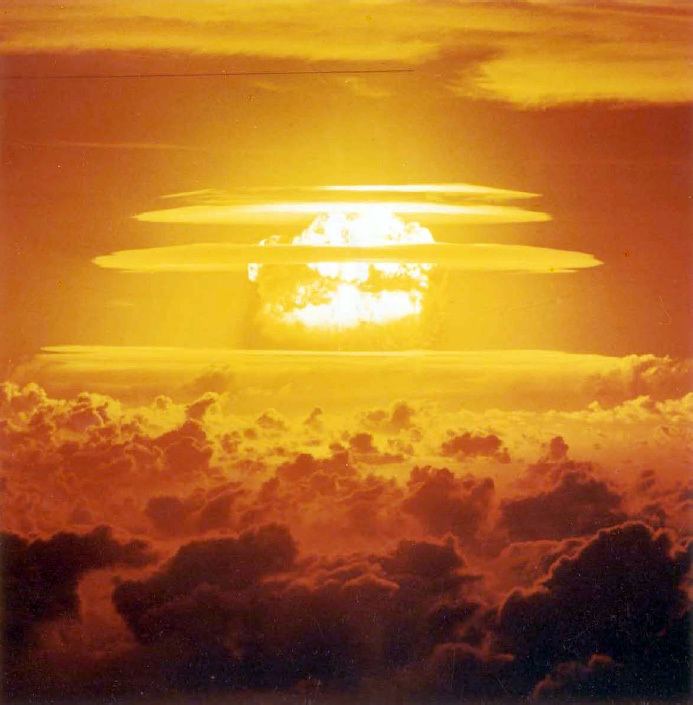 | ||
Similar Operation Crossroads, Trinity (nuclear test), Halifax Explosion | ||
The deadly miscalculation at castle bravo v3 0
Castle Bravo was the code name given to the first United States test of a dry fuel hydrogen bomb, detonated on March 1, 1954, at Bikini Atoll, Marshall Islands, as the first test of Operation Castle. The Castle Bravo device was the most powerful nuclear device ever detonated by the United States, with a yield of 15 megatons of TNT (30% of the energy produced by the most powerful device ever detonated, the Tsar Bomba). That yield, far exceeding the expected yield of 4 to 8 megatons, combined with shifting winds, led to the most significant accidental radioactive contamination ever caused by the United States.
Contents
- The deadly miscalculation at castle bravo v3 0
- Castle bravo nuclear test
- The primary system
- Deuterium and lithium
- SHRIMPs indirect drive
- The secondary assembly
- Use of boron
- Detonation
- High yield
- Fallout
- Weapon history
- Cultural impact
- References
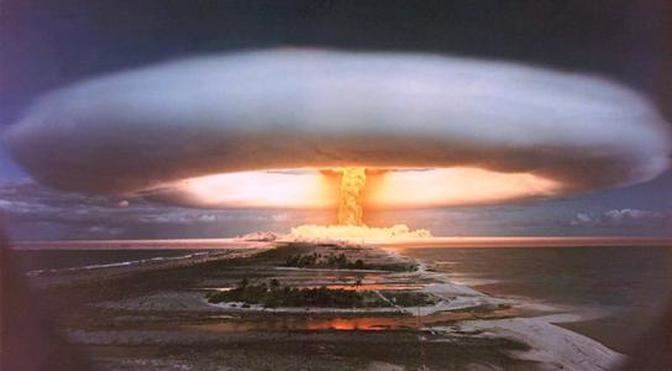
fallout from the detonation—intended to be a secret test—fell on residents of Rongelap and Utirik atolls and spread around the world. The islanders were not evacuated until three days later and suffered radiation sickness. They were returned to the islands three years later but were removed again when their island was found to be unsafe. The 23 crewmembers of the Japanese fishing vessel Daigo Fukuryū Maru ("Lucky Dragon No. 5") were also contaminated by fallout, experiencing acute radiation syndrome. The blast created an international reaction about atmospheric thermonuclear testing.
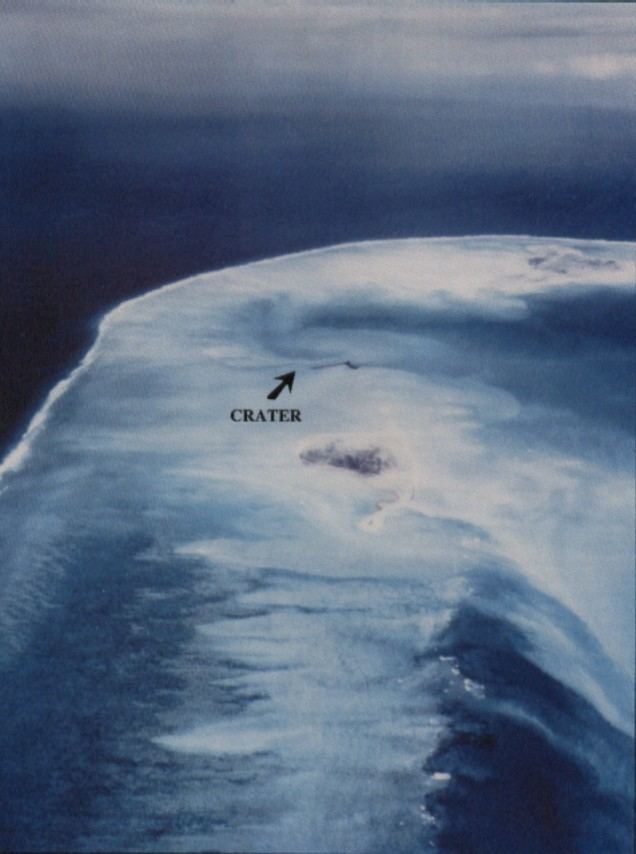
The Bravo Crater is located at 11°41′50″N 165°16′19″E. The remains of the Castle Bravo causeway are at 11°42′6″N 165°17′7″E.

Castle bravo nuclear test
The primary system
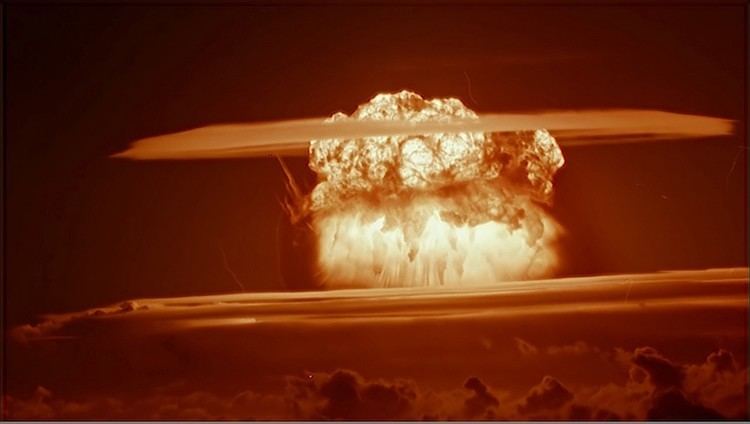
The Castle Bravo device was housed in a cylinder that weighed 23,500 pounds (10.5 long tons; 11.8 short tons) and measured 179.5 inches (4.56 m) in length and 53.9 inches (1.37 m) in diameter.
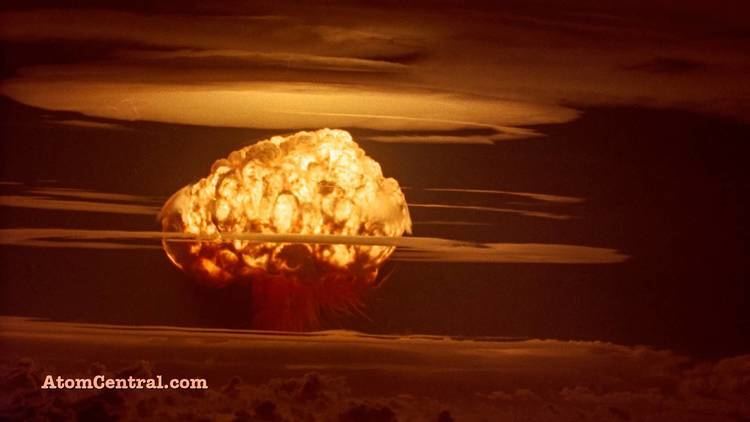
The primary device was a COBRA tritium-boosted atomic bomb provided by Los Alamos Scientific Laboratory, a very compact MK-7 device. This boosted fission device was tested in the Upshot Knothole Climax event and yielded 61 kilotonnes of TNT (260 TJ) (out of 50–70 kt expected yield range), so that the planned operation Domino could be cancelled before the coming presidential election. The implosion system weighed 410 kg (900 lb) and used the more powerful Cyclotol 75/25 instead of the Composition B used in most bombs at that time, with the assembled module weighing 830 kg (1,840 lb) and measuring 770 mm (30.5 in) across. It was located at the end of the device, which, as seen in the declassified film, shows a small cone projecting from the ballistic case. This cone is the part of the parabola that was used to focus the radiation emanating from the primary to the secondary.
Deuterium and lithium
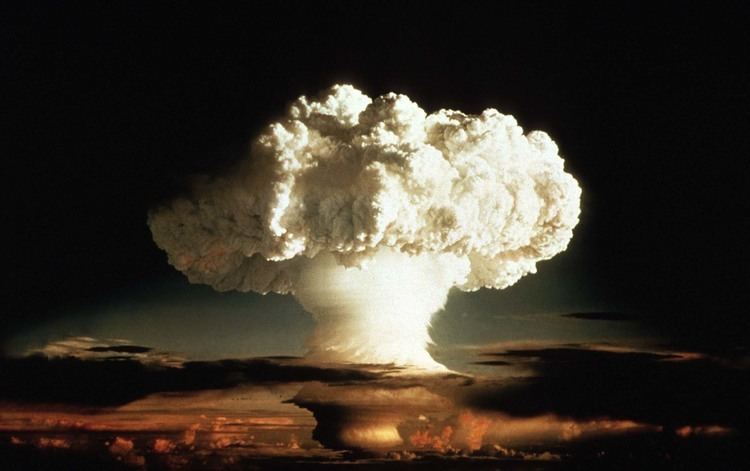
The device was called shrimp and had the same basic configuration (radiation implosion) as the Ivy Mike wet device, except with a different type of fusion fuel. SHRIMP used lithium deuteride (LiD), which is solid at room temperature; Ivy Mike used cryogenic liquid deuterium (D2), which required elaborate cooling equipment. Castle Bravo was the first test by the United States of a practical deliverable fusion bomb (hydrogen bomb), even though the TX-21 as proof-tested in the Bravo event was not weaponized. The successful test rendered obsolete the cryogenic design used by Ivy Mike and its weaponized derivative, the JUGHEAD, which was slated to be tested as the initial Castle Yankee. It also used a 7075 aluminium 9.5 cm thick ballistic case. Aluminium was used in an effort to drastically reduce the bomb's weight and simultaneously to provide sufficient radiation confinement time and to raise yield, a departure from the heavy stainless steel casing (304L or MIM 316L) employed by contemporary weapon-projects.
The SHRIMP was at least in theory and in many aspects identical in geometry to the RUNT and RUNT II devices later proof-fired in Castle Romeo and Castle Yankee respectively. On paper it was a scaled-downed version of these devices, and its origins can be traced back to the spring and summer of 1953. The United States Air Force indicated the importance of lighter thermonuclear weapons for delivery by the B-47 Stratojet and B-58 Hustler. Los Alamos National Laboratory responded to this indication with a follow-up enriched version of the RUNT scaled down to a 3/4 scale radiation-implosion system called the SHRIMP. The proposed weight reduction (from TX-17’s 42,000 pounds (19,000 kg) to TX-21’s 25,000 pounds (11,000 kg)) would provide the Air Force with a much more versatile deliverable gravity bomb. The final version tested in Castle used partially enriched lithium as its fusion fuel. Natural lithium is a mixture of lithium-6 and lithium-7 isotopes (with 7.5% of the former). The enriched lithium used in Bravo was nominally 40% lithium-6. The fuel slugs varied in enrichment from 37 to 40% in 6Li, and the slugs with lower enrichment were positioned at the end of the fusion-fuel chamber, away from the primary. The lower levels of lithium enrichment in the fuel slugs, compared with the ALARM CLOCK and many later hydrogen weapons, were due to shortages in enriched lithium at that time, as the first of the Alloy Development Plants (ADP) started production by the fall of 1953. The volume of LiD fuel used was approximately 60% the volume of the fusion fuel filling used in the wet SAUSAGE and dry RUNT I device, or about 500 liters (110 imp gal; 130 U.S. gal), corresponding to about 400 kg of lithium deuteride (as LiD has a density of 0.78201 g/cm3). The mixture cost about 4.54 USD/g at that time. The fusion burn efficiency was ~25.1%, the highest attained efficiency of the first TN weapon generation. This efficiency is well within the figures given in a November 1956 statement, when a DOD official disclosed that thermonuclear devices with efficiencies ranging from 15% to up about 40% had been tested. Hans Bethe reportedly stated independently that those weapons tested during Castle had (fusion) efficiencies varying from as low as 15% to up about 25%.
The thermonuclear burn would produce (in a manner similar to the fission fuel in the primary) pulsations (generations) of high-energy neutrons with an average temperature of 14 MeV through the Jetter’s cycle. The cycle is a combination of endothermic and exothermic neutronic reactions involving lithium and deuterium/tritium. The reaction's neutronicity was estimated at ~0.885 (for a Lawson criterion of ~1.5). These figures do not count the 7Li isotope, where the 7LiD has a neutronicity of ~0.835 and, along with the cross-sections, were given as group averages from about 2.40 to approximately 2.55 MeV and from 14.0 to 14.1 MeV; the small power group is not statistically present (see also Nuclear fusion). As SHRIMP, along with the RUNT I and ALARM CLOCK were to be high-yield shots required to assure the thermonuclear "emergency capability", their fusion fuel may have been spiked with additional tritium, in the form of 6LiT. All of the high-energy 14 MeV neutrons would cause fission in the uranium fusion tamper wrapped around the secondary and the spark plug's plutonium rod. The ratio of deuterium (and tritium) atoms burned by 14 MeV neutrons spawned by the burning was expected to vary from 5:1 to 3:1, a standardisation derived from Mike, while for these estimations, the ratio of 3:1 was predominantly used in ISRINEX. The neutronicity of the fusion reactions harnessed by the fusion tamper would dramatically increase the yield of the device.
SHRIMP’s indirect drive
Attached to the cylindrical ballistic case was a natural-uranium liner, the radiation case. The SHRIMP design used an approximately 2.5 cm thick uranium radiation case. Its internal surface was lined with ~240 μm thick copper liner made from 0.08 μm thick copper foil, due to copper possessing excellent reflecting properties, increasing the overall albedo of the hohlraum. hohlraum albedo is a very important design parameter for any inertial-confinement configuration. A relatively high albedo permits higher interstage coupling due to the more favorable azimuthal and latitudinal angles of reflected radiation. The limiting value of the albedo for high-Z materials is reached when the thickness is 5–10 g/cm2, or 0.5–1.0 free paths. Thus, a hohlraum made of uranium much thicker than a free path of uranium would be disadvantageous in terms of bomb weight and use of raw materials. At the same time the angular anisotropy increases as the atomic number of the scatterer material is reduced. Thus the use of copper, or in other devices of gold or aluminium, as hohlraum liners is generally imperative as the greater the value of Zeff of the scatterer the greater this absorption probability will be. There are 2 sources of X-rays in the hohlraum; primary's irradiance which is dominant at the beginning and during the pulse rise and the wall which is important during the required radiation temperature's (Tr) plateau. The primary emits radiation in a manner similar to a flash bulb, and the secondary needs constant Tr to properly implode. This constant wall temperature is dictated by the ablation pressure requirements to drive compression which lay on average at about 0.4 keV (out of a range of 0.2 to 2 keV) corresponding to several thousand kelvins. Wall temperature depended to the temperature of the primary's core which peaked at about 5.4 keV during boosted-fission. The final wall-temperature, which corresponds to energy of the wall-reradiated X-rays to the secondary's pusher, also drops due to losses from the hohlraum material itself. Natural uranium nails, lined to the top of their head with copper, attached the radiation case to the ballistic case. The nails were bolted in vertical arrays and in a double-shear configuration to better distribute the shear loads. This method of attaching the radiation case to the ballistic case was first used successfully in the Ivy Mike device. The radiation case had a parabolic end, which housed the COBRA primary that was employed to create the conditions needed to start the fusion reaction, and its other end was a right circular cylinder, as also seen in Bravo's declassified film.
The space between the uranium fusion tamper (also termed pusher; both terms can be used interchangeably) which is the metal cladding encasing the secondary and the case formed a radiation channel to conduct X-rays from the primary to the secondary assembly; the interstage. It is one of the most closely guarded secrets of a multi-stage thermonuclear weapon. Implosion of the secondary assembly is indirectly driven, and the techniques used in the interstage to smooth the spatial profile (i.e. reduce coherence and nonuniformities) of the primary’s irradiance are of utmost importance. This was done with the introduction of the channel filler – an optical element used as a refractive medium, also called random-phase plate. This "plate" was a polystyrene plastic foam filling, extruded or impregnated with a low-molecular-weight hydrocarbon (possibly methane gas), which turned to a low-Z plasma from the X-rays, and tamped (not to be confused with the fusion tamper) the sputtering effect that choked the radiation from compressing the secondary. Sputtering is the manifestation of the underdense plasma corona of the ablating hohlraum and the tamper surfaces. It is a problem, also shared by magnetically confined fusion reactors (see Tokamak), that has to do with the ablated particles, the blown-off uranium (or Pb–Bi alloy, depending on the "cocktail", or high-Z element mixture, of the hohlraum design to tailor its opacity), which fly inside the radiation channel and absorb radiation or reflect it, contributing negatively to the radiation mirroring (also termed "ducting" in the TN jargon). The re-emitted X-rays from the radiation case must be deposited uniformly on the outer walls of the secondary’s tamper and ablate it externally, driving the thermonuclear fuel capsule (increasing the density and temperature of the fusion fuel) to the point needed to sustain a thermonuclear reaction. (see Nuclear weapon design). This point is above the threshold where the fusion fuel would turn opaque to its own emitting radiation, as determined from its Rosseland opacity. After all, for any hydrogen weapon system to work, this radiative equilibrium must be reached together with the compression equilibrium between the fusion tamper and the sparkplug (see below), hence their name equilibrium supers.
Since the ablative process takes place on both walls of the radiation channel, a numerical estimate made with ISRINEX (a thermonuclear explosion simulation program) suggested that the uranium tamper also had a thickness of 2.5 cm, so that an equal pressure would be applied to both walls of the hohlraum. The rocket effect on the surface of tamper's wall created by the ablation of its several superficial layers would force an equal mass of uranium that rested in the remainder of the tamper to speed inwards, thus imploding the core. At the same time, the rocket effect on the surface of the hohlraum would force the radiation case to speed outwards. The ballistic case would confine the exploding radiation case for as long as necessary. The fact that the tamper material was uranium enriched in 235U was deduced based on the final fission reaction fragments detected in the radiochemical analysis, conclusively shown by the 237U found by the Japanese in the shot debris. The first-generation thermonuclear weapons (MK-14, 16, 17, 21, 22 and 24) all used uranium tampers enriched to 37.5% 235U. The exception to this was the MK-15 ZOMBIE that used a 93.5% enriched fission jacket.
The secondary assembly
The secondary assembly was the actual SHRIMP component of the weapon. The weapon, like most contemporary weapons at that time, bore the same code-name as the secondary. The secondary was situated in the cylindrical end of the device, where its end was locked to the radiation case by a type of mortise and tenon joint. The hohlraum at its cylindrical end had an internal projection, which nested the secondary and had better structural strength to support the secondary’s assembly, which had most of the device's mass. A visualisation to this is that the joint looked much like a cap (the secondary) fitted in a cone (the projection of the radiation case). Any other supporting structure would cause radiation transfer blockade and complex vibrational behavior. With this form of joint, the secondary and the hohlraum behaved as "one mass" sharing common eigenvalues (eigenfrequencies and eigenmodes). The other end of the radiation case was shaped like a parabola to focus the radiation emitted by the fission device. The secondary assembly was an elongated truncated cone. From its front part to its aft section it was steeply tapered. Tapering was used for two reasons. First, radiation drops sharply by distance, as a function divided by the square of the distance, and radiation coupling is relatively poor. This made the use of a higher mass of the then scarce fusion fuel in the rear end of the secondary assembly inefficient and the whole device wasteful. This was also the reason why the lower-enriched slugs of fusion fuel were placed far aft of the fuel capsule. Second, as the primary could not illuminate the whole surface of the hohlraum, in part due to the large axial length of the secondary, relatively small solid angles would be effective to compress the secondary, leading to poor radiation focusing. By tapering, the hohlraum acted in a form of a quasi-parabola in its aft section without having to machine the radiation case to a parabola at both ends, amplifying the radiation focusing and enabling a streamlined production line, as it was cheaper, faster and easier to manufacture the radiation case with only one parabolic end. The tapering in this design was much steeper than its cousins, the RUNT and the ALARM CLOCK devices. SHRIMP's tapering apparently made the whole secondary assembly resemble the body of a shrimp. The secondary's length is defined by the two pairs of dark-colored diagnostic hot spot pipes attached to the middle and left section of the device. These pipe sections 8 5⁄8 inches (220 mm) in diameter by 40 feet (12 m) long were butt-welded end-to-end to the ballistic case leading out to the top of the shot cab. They would carry the initial reaction's light up to the array of 12 mirror towers built in an arc on the artificial 1-acre (0.40 ha) shot island created for the event. From those pipes, mirrors would reflect early bomb light from the bomb casing to a series of remote high-speed cameras, so that Los Alamos could determine both the simultaneity of the design (i.e. the time interval between primary's firing and secondary's ignition) and the thermonuclear burn rate in these two crucial areas of the secondary device.
This secondary assembly device contained the lithium deuteride fusion fuel in a stainless-steel canister. Running down to the center of the secondary was a ~1.3 cm thick hollow cylindrical rod of plutonium, nested in the steel canister. This was the sparkplug, a tritium-boosted fission device, which had an aperture of about 0.5 cm at its center. The sparkplug was charged with about 4 grams of tritium and, imploding together with the secondary's compression, was timed to detonate by the first generations of neutrons that arrived from the primary. Timing was defined by the geometric characteristics of the sparkplug (its uncompressed annular radius), which detonated when its criticality, or keff, transcended 1. Its purpose was to compress the fusion material around it from its inside, equally applying pressure with the tamper. The compression factor of the fusion fuel and its adiabatic compression energy determined the minimal energy required for the sparkplug to counteract the compression of the fusion fuel and the tamper’s momentum. The sparkplug weighed about 18 kg, and its initial firing yielded 0.6 kilotonnes of TNT (2.5 TJ). Then it would be completely fissioned by the fusion neutrons, contributing about 330 kilotonnes of TNT (1,400 TJ) to the total yield. The energy required by the sparkplug to counteract the compression of the fusion fuel was lower than the primary’s yield because coupling of the primary’s energy in the hohlraum is accompanied by losses due to the difference between the X-ray fireball and the hohlraum temperatures. The neutrons entered the assembly by a small hole through the ~28 cm thick 238U blast-heat shield. It was positioned in front of the secondary assembly facing the primary. Similar to the tamper-fusion capsule assembly, the shield was shaped as a circular frustum, with its small diameter facing the primary's side, and with its large diameter locked by a type of mortise and tenon joint to the rest of the secondary assembly. The shield-tamper ensemble can be visualized as a circular bifrustum. All parts of the tamper were similarly locked together to provide structural support and rigidity to the secondary assembly. Surrounding the fusion-fuel–spark-plug assembly was the uranium tamper with a standoff air-gap about 0.9 cm wide that was to increase the tamper's momentum, a levitation technique used as early as Operation Sandstone and famously quoted by Ted Taylor as hammer-on-the-nail-impact. Since there were also technical concerns that high-Z tamper material would mix rapidly with the relatively low-density fusion fuel, leading to unacceptably large radiation losses the stand-off gap also acted as a buffer in order to hinder to some extent the unavoidable and undesirable Taylor mixing.
Use of boron
Boron was also used at many locations in this dry system; it has a high cross-section for the absorption of slow neutrons, which fission 235U and 239Pu, but a low cross-section for the absorption of fast neutrons, which fission 238U. Because of this characteristic, 10B deposited onto the surface of the secondary stage would prevent predetonation of the sparkplug by stray neutrons from the primary without interfering with the subsequent fissioning of the 238U of the fusion tamper wrapping the secondary. Boron also played a role in increasing the compressive plasma pressure around the secondary by blocking the sputtering effect, leading to higher thermonuclear efficiency. Because the structural foam holding the secondary in place within the casing was doped with 10B, the secondary was compressed more highly, at a cost of some radiated neutrons. An example of the usefulness of 10B can be seen by the fact that the fizzled Castle Koon MORGENSTERN device didn't use it in its design. As a result, the intense neutron flux from its RACER IV primary pre-detonated the spherical fission sparkplug, which in turn "cooked" the fusion fuel, leading to an overall poor compression. It should be noted, that the plastic's low molecular weight is unable to implode the secondary's mass. Its plasma-pressure is confined in the boiled-off sections of the tamper and the radiation case so that material from neither of these two walls can enter the radiation channel that has to be open for the radiation transit.
Detonation
The device was mounted in a "shot cab" on an artificial island built on a reef off Namu Island, in the Bikini Atoll. A sizable array of diagnostic instruments was trained on it, including high-speed cameras trained through an arc of mirror towers around the shot cab.
The detonation took place at 06:45 on March 1, 1954 local time (18:45 on February 28 GMT).
When Bravo was detonated, it formed a fireball almost 4.5 miles (7.2 km) across within a second. This fireball was visible on Kwajalein Atoll over 250 miles (400 km) away. The explosion left a crater 6,500 feet (2,000 m) in diameter and 250 feet (76 m) in depth. The mushroom cloud reached a height of 47,000 feet (14,000 m) and a diameter of 7 miles (11 km) in about a minute, a height of 130,000 feet (40 km) and 62 mi (100 km) in diameter in less than 10 minutes and was expanding at more than 100 meters per second (360 km/h; 220 mph). As a result of the blast, the cloud contaminated more than 7,000 square miles (18,000 km2) of the surrounding Pacific Ocean, including some of the surrounding small islands like Rongerik, Rongelap and Utirik.
In terms of TNT equivalence, Castle Bravo was about 1,000 times more powerful than each of the atomic bombs that were dropped on Hiroshima and Nagasaki during World War II. Castle Bravo is the fifth largest nuclear explosion in history, exceeded by the Soviet tests of Tsar Bomba at approximately 50 Mt, Test 219 at 24.2 Mt, and two other ~20 Mt Soviet tests in 1962 at Novaya Zemlya.
High yield
The yield of 15 megatons was 3 times that of the 5 Mt predicted by its designers. The cause of the higher yield was a theoretical error made by designers of the device at Los Alamos National Laboratory. They considered only the lithium-6 isotope in the lithium-deuteride secondary to be reactive; the lithium-7 isotope, accounting for 60% of the lithium content, was assumed to be inert. It was expected that the lithium-6 isotope would absorb a neutron from the fissioning plutonium and emit an alpha particle and tritium in the process, of which the latter would then fuse with the deuterium and increase the yield in a predicted manner. Lithium-6 indeed reacted in this manner.
It was assumed that the lithium-7 would absorb one neutron, producing lithium-8, which decays (through beryllium-8) to a pair of alpha particles on a timescale of seconds, vastly longer than the timescale of nuclear detonation. However, when lithium-7 is bombarded with energetic neutrons, rather than simply absorbing a neutron, it captures the neutron and decays almost instantly into an alpha particle, a tritium nucleus, and another neutron. As a result, much more tritium was produced than expected, the extra tritium fusing with deuterium and producing an extra neutron. The extra neutron produced by fusion and the extra neutron released directly by lithium-7 decay produced a much larger neutron flux. The result was greatly increased fissioning of the uranium tamper and increased yield.
This resultant extra fuel (both lithium-6 and lithium-7) contributed greatly to the fusion reactions and neutron production and in this manner greatly increased the device's explosive output. The test used lithium with a high percentage of lithium-7 only because lithium-6 was then scarce and expensive; the later Castle Union test used almost pure lithium-6. Had sufficient lithium-6 been available, the usability of the common lithium-7 might not have been discovered.
Fallout
The fission reactions of the natural uranium tamper were quite dirty, producing a large amount of fallout. That, combined with the much-larger-than-expected yield and a major wind shift, produced some very serious consequences. In the de-classified film Operation Castle, task force commander Major General Percy Clarkson points to a diagram indicating that the wind shift was still in the range of "acceptable fallout", although just barely.
The decision to carry out the Bravo test under the prevailing winds was made by Dr. Alvin C. Graves, the Scientific Director of Operation Castle. Graves had total authority over detonating the weapon, above that of the military Commander of Operation Castle. Graves appears in the widely available film of the earlier 1952 test "Ivy Mike", which examines the last-minute fallout decisions. The narrator, Western actor Reed Hadley, is filmed aboard the control ship in that film, showing the final conference. Hadley points out that 20,000 people live in the potential area of the fallout. He asks the control panel scientist if the test can be aborted and is told "yes", but it would ruin all their preparations in setting up timed measuring instruments in the race against the Russians. In Mike the fallout correctly landed north of the inhabited area but, in the 1954 Bravo test, there was a lot of wind shear, and the wind that was blowing north the day before the test steadily veered towards the east.
Radioactive fallout was spread eastward onto the inhabited Rongelap and Rongerik atolls, which were evacuated 48 hours after the detonation. Ultimately, 15 islands and atolls were contaminated, and by 1963 Marshall Islands natives began to suffer from thyroid tumors, including 20 of 29 Rongelap children at the time of Bravo, and many birth defects were reported. The islanders received compensation from the U.S. federal government, relative to how much contamination they received, beginning in 1956; by 1995 the Nuclear Claims Tribunal reported that it had awarded $43.2 million, nearly its entire fund, to 1,196 claimants for 1,311 illnesses. A medical study, named Project 4.1, studied the effects of the fallout on the islanders.
Although the atmospheric fallout plume drifted eastward, once fallout landed in the water it was carried in several directions by ocean currents, including northwest and southwest.
A Japanese fishing boat, Daigo Fukuryū Maru (Lucky Dragon No.5), came in direct contact with the fallout, which caused many of the crew to grow ill; one died of a secondary infection. This resulted in an international incident and reignited Japanese concerns about radiation, especially as Japanese citizens were once more adversely affected by U.S. nuclear weapons. The official U.S. position had been that the growth in the strength of atomic bombs was not accompanied by an equivalent growth in radioactivity released. Japanese scientists who had collected data from the fishing vessel disagreed with this. Sir Joseph Rotblat, working at St Bartholomew's Hospital, London, demonstrated that the contamination caused by the fallout from the test was far greater than that stated officially. Rotblat was able to deduce that the bomb had three stages and showed that the fission phase at the end of the explosion increased the amount of radioactivity a thousandfold. Rotblat's paper was taken up by the media, and the outcry in Japan reached such a level that diplomatic relations became strained and the incident was even dubbed by some as "a second Hiroshima". Nevertheless, the Japanese and U.S. governments quickly reached a political settlement, with the transfer to Japan of US $15,300,000 as compensation, with the surviving victims receiving about ¥ 2 million each ($5,550 in 1954, or about $49,500 in 2017) It was also agreed that the victims would not be given Hibakusha status.
Unanticipated fallout and the radiation emitted by it also affected many of the vessels and personnel involved in the test, in some cases forcing them into bunkers for several hours. In contrast to the crew of the Lucky Dragon No. 5, who did not appreciate the hazard and therefore did not take shelter in the hold of their ship, or refrain from inhaling the fallout dust, the firing crew that triggered the explosion was able to safely shelter in their firing station when they noticed the wind was carrying the fallout in the unanticipated direction towards the island of Enyu on the Bikini Atoll where they were located, with the fire crew sheltering in place ("buttoning up") for several hours until outside radiation decayed to safer levels. 250 rads were recorded above the bunker.
Sixteen crew members of the aircraft carrier USS Bairoko received beta burns and there was an increased cancer rate among its crew. Radioactive contamination also affected many of the testing facilities built on other islands of the Bikini atoll system.
The fallout spread traces of radioactive material as far as Australia, India and Japan, and even the United States and parts of Europe. Though organized as a secret test, Castle Bravo quickly became an international incident, prompting calls for a ban on the atmospheric testing of thermonuclear devices.
A worldwide network of gummed film stations was established to monitor fallout following Operation Castle. Although meteorological data was poor, a general connection of tropospheric flow patterns with observed fallout was evident. There was a tendency for fallout/debris to remain in tropical latitudes, with incursions into the temperate regions associated with meteorological disturbances of the predominantly zonal flow. Outside of the tropics, the Southwestern United States received the greatest total fallout, about five times that received in Japan.
Stratospheric fallout particles of strontium-90 from the test were later captured with balloon-borne air filters used to sample the air at stratospheric altitudes, the research (Project Ashcan) was conducted to better understand the stratosphere, fallout times and arrive at more accurate meteorological models after hindcasting.
In addition to the radiological accident, the unexpectedly high yield of the device severely damaged many of the permanent buildings on the control site island on the far side of the atoll. Little of the desired diagnostic data on the shot was collected; many instruments designed to transmit their data back before being destroyed by the blast were instead vaporized instantly, while most of the instruments that were expected to be recovered for data retrieval were destroyed by the blast.
The fallout also affected islanders who had previously inhabited the atoll, and who returned there some time after the tests. This was found to be due to the presence of radioactive caesium in locally grown coconut milk. Plants and trees absorb potassium as part of the normal biological process, but will also readily absorb caesium if present, being of the same group on the periodic table, and therefore very similar chemically. Islanders consuming contaminated coconut milk were found to have abnormally high concentrations of caesium in their bodies and then had to be evacuated from the atoll a second time.
The American magazine Consumer Reports warned of the contamination of milk with strontium-90.
Weapon history
The Soviet Union had previously used lithium deuteride in its Sloika design (known as the "Joe-4" in the U.S.), in 1953. It was not a true hydrogen bomb; fusion provided only 15–20% of its yield, most coming from boosted fission reactions. Its yield was 400 kilotons, and it could not be infinitely scaled, as with a true thermonuclear device.
The Teller–Ulam-based "Ivy Mike" device had a much greater yield of 10.4 Mt, but most of this also came from fission: 77% of the total came from fast fission of its natural-uranium tamper.
Castle Bravo had the greatest yield of any U.S. nuclear test, 15 Mt, though again, a substantial fraction came from fission. In the Teller–Ulam design, the fission and fusion stages were kept physically separate in a reflective cavity. The radiation from the exploding fission primary brought the fuel in the fusion secondary to critical density and pressure, setting off thermonuclear (fusion) chain reactions, which in turn set off a tertiary fissioning of the bomb's 238U fusion tamper and casing. Consequently, this type of bomb is also known as a "fission-fusion-fission" device. The Soviet researchers, led by Andrei Sakharov, developed and tested their first Teller–Ulam device in 1955.
The publication of the Bravo fallout analysis was a militarily sensitive issue, with Joseph Rotblat possibly deducing the staging nature of the Castle Bravo device by studying the ratio and presence of tell-tale isotopes, namely uranium-237, present in the fallout. This information could potentially reveal the means by which megaton-yield nuclear devices achieve their yield. Soviet scientist Sakharov hit upon what the Soviet Union regarded as "Sakharov's third idea" during the month after the Castle Bravo test, the final piece of the puzzle being the idea that the compression of the secondary can be accomplished by the primary's X-rays before fusion began.
The Shrimp device design later evolved into the Mark 21 nuclear bomb, of which 275 units were produced, weighing 15,000 pounds (6,800 kg) and measuring 12.5 feet (3.8 m) long and 56 inches (1.4 m) in diameter. This 4-megaton bomb was produced until July 1956. In 1957, it was converted into the Mark 36 nuclear bomb and entered into production again.
Cultural impact
As a result of the extensive fallout, Nevil Shute wrote the novel On the Beach, which was released in 1957. The novel is about a war that released so much radioactive fallout that all the life in the Northern Hemisphere disappeared, while the Southern Hemisphere awaited a similar fate. However the American government voiced a criticism of this premise—a threat of extinction from nuclear war—because they did not have enough nuclear weapons to cause human extinction. Similarly the premise that all of humanity would die following a nuclear war and only the "cockroaches would survive" is critically dealt with in the 1988 book Would the Insects Inherit the Earth, and Other Subjects of Concern to Those Who Worry About Nuclear War. A combination of the Castle Bravo detonation, alongside the subsequent poisoning of the Lucky Dragon 5, and the resultant flashbacks to the bombings of Hiroshima and Nagasaki all culminated in the 1954 creation of what is perhaps Japan's most widely recognized media icon, Godzilla.
In 2013 the Defense Threat Reduction Agency released Castle Bravo: Fifty Years of Legend and Lore.
During the opening scene of the 2014 American Godzilla reboot and in the prequel comic Godzilla: Awakening, the Castle Bravo nuclear test was an attempt to kill Godzilla and a prehistoric parasite called "Shinomura". Godzilla, however, survived the "test", despite humanity believing otherwise, while the Shinomura was incinerated.
